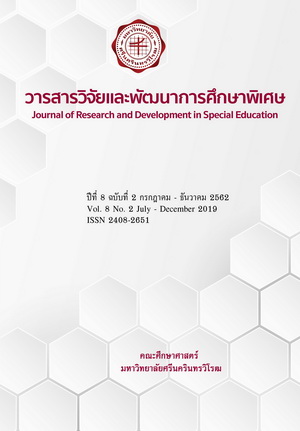การสังเคราะห์บทความวิจัยด้านดนตรีบำบัดในโรงเรียน: การทบทวนวรรณกรรมอย่างเป็นระบบ (SYSTHESIS OF RESEARCH ARTICLES ON MUSIC THERAPY IN SCHOOL: A SYSTEMATIC REVIEW)
Abstract
บทคัดย่อการวิจัยในครั้งนี้มีวัตถุประสงค์เพื่อสังเคราะห์งานวิจัยด้านคนตรีบำบัดในโรงเรียน จำนวนทั้งหมด39 เรื่อง ซึ่งเป็นบทความวิจัยทางดนตรีบำบัดที่ศึกษาผลของกิจกรรมดนตรีบำบัดในบริบทโรงเรียนที่ถูกตีพิมพ์ นับตั้งแต่เริ่มมีการเผยแพร่จนถึงปี ค.ศ.2017 จาก ฐานข้อมูลออนไลน์ EBSCOhost และ OXFORDACADEMIC โดยแบ่งการสังเคราะห์ออกเป็น 3 ด้าน คือ 1) ด้านการตีพิมพ์และนักวิจัย 2) ด้านระเบียบวิธีวิจัย และ 3) ด้านเนื้อหางานวิจัยและกิจกรรมทางดนตรีบำบัด วิเคราะห์ข้อมูลโดยใช้สถิติเชิงบรรยาย(Descriptive Statistics) ได้แก่ การแจกแจงความถี่และร้อยละผลที่ได้จากการสังเคราะห์งานวิจัยพบว่า งานวิจัยส่วนใหญ่ได้รับการตีพิมพ์ในปี ค.ศ. 2006 - 2010(38.46%) มาจากวารสาร Journal of Music Therapy มากที่สุด (51.28%) โดยแบบแผนการทดลองที่ใช้ส่วนใหญ่ คือ Randomized control-group pretest-posttest designs (17.95%) และใช้การวิเคราะห์ข้อมูลแบบ One-Way ANOVA และ Descriptive statistics มากที่สุด (15.38%) กลุ่มตัวอย่างโดยส่วนใหญ่เป็นเด็กที่มีความบกพร่องทางด้านพฤติกรรมหรืออารมณ์ (20.51%) มีการจัดรูปแบบชั้นเรียนเป็นชั้นเรียนแยกมากที่สุด (33.33%) เครื่องมือที่ใช้โดยส่วนใหญ่คือเครื่องมือประเมินทักษะทางด้านอารมณ์(26.64%) และกิจกรรมดนตรีบำบัดที่ใช้มากที่สุดเป็นกิจกรรมการร้องเพลง การฟังเพลง การเล่นเครื่องดนตรี และกิจกรรมเคลื่อนไหว (25.64%) AbstractThe purpose of this study was to synthesize research articles on music therapy inschool settings. 39 research articles were identified to investigate effects of music therapyinterventions implemented in schools. The articles were published from 2017 back to theearlier publication found and gathered from online databases EBSCOhost and OXFORDACADEMIC.The synthesis of research articles was categorized into three areas:1)publicationsand researchers, 2) research methodology, and 3) research contents and music interventions.Descriptive statistics (frequency and percentages) were used to analyze the data.The result of the systematic review indicated that most of the research articles wereissued from 2006 to 2010 (38.46%) and published by Journal of Music Therapy (51.28%).The most frequently used research design was Randomized control-group pretest-posttestdesigns (17.95%), and the most common data analysis method was One-Way ANOVA andDescriptive statistics descriptive statistics (15.38%). The majority of participants were diagnosedas behavioral or emotional disorders (20.51%). Most studies were conducted in separatedclassroom (33.33%).Singing, music listening, playing music instruments and music movementwere mainly used as music activities (25.64%).Downloads
Download data is not yet available.




